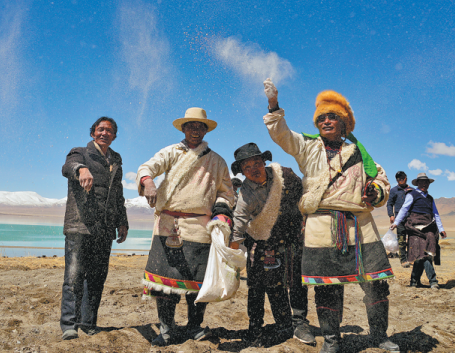At dawn, Dorje puts on a heavy cotton coat and a hat, carries a bag on his back and walks out of his house into the vast alpine meadows. 
The herdsman, in his 40s, has been living all his life in Pasum, a village located at the foot of Mount Qomolangma, or Mount Everest, the world's highest peak. Dorje's village is administered by the Zhaxizom township, located at about 4,200 meters above sea level. It is the closest human habitat to the mountain.
He leans on the grass under the sun while leisurely keeping an eye on his flock of sheep in the distance, though there is one thing bothering him-altitude sickness, quite uncommon for a local Tibetan.
"I have been suffering from frequent headaches since I was a kid, but look, headaches never bother my sheep," he says.
Not far from where Dorje lives, a team of over 30 Chinese surveyors are taking an arduous journey to the peak, aiming to remeasure the exact height of the mountain.
Dorje has heard about the news and cracks a joke. "Is the mountain getting higher? Heavens, my head will ache more if it gets any higher," he says.
Dorje is not surprised by the number of tourists and climbers who come to the area frequently from April to October every year. But this year, the COVID-19 pandemic has affected tourism and forced mountain-climbing to be suspended.
He goes on herding his sheep to another piece of grass that has been breaking through the hard ground. "Spring seems to be late this year, but my lambs need this grass to grow," he says.
The weather is less predictable at the foot of the Himalayas and the spring season is about two months later than that of other cities like Lhasa, the capital of the Tibet autonomous region.
In a village nearby, locals are just beginning this year's spring plowing. Gesang, 51, goes to his cropland early in the morning to hold a plowing ceremony.
He takes with him some flora, roasted highland barley flour, water, and a sacred book used for praying for a bumper harvest.
At such high altitude, highland barley is the most-favored plant for the soil. It can be grounded into flour and made into zanba, a staple food for the Tibetans, or brewed into highland barley liquor.
Gesang flings a handful of roasted highland barley flour up in the air and chants the prayers for a good harvest in autumn. After the ceremony, he begins to sow the seeds.
Children also participate in farming. Tenzin, a 6-year-old boy, stands on the plow for it to bite deeper into the soil, his hands tightly gripping the horsetail to keep balance. The boy goes to a village kindergarten, but schooling has not resumed due to the pandemic.
Yet life at the "roof of the world" is not only about surviving the hardships of nature. Locals also know how to make their life as pleasing as possible.
Lochu, another village, offers hot spring baths for local people to drive away their cold and soothe pains from chronic diseases such as arthritis and rheumatism.
Samzhub, 37, is one to enjoy a hot spring bath in a Tibetan-style adobe house in the village.
"We get tired working in the field, but a good hot bath makes the stress go away. The hot spring baths also work well to prevent these plateau diseases," he says.
Xinhua |






7740f3b5-9ecb-438e-9052-76cb2d4bb671.jpg)

